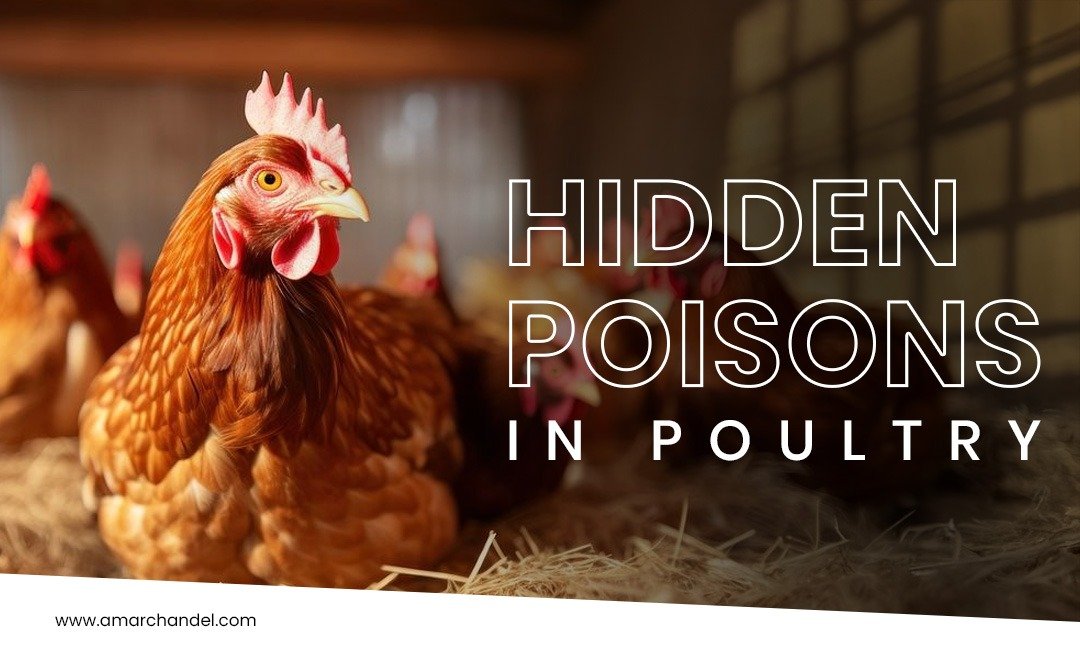For decades, the poultry industry across the globe — and increasingly in India — has been quietly feeding consumers not just meat, but a cocktail of drugs, hormones, and toxins. While the West has begun reckoning with this problem, India is now facing a similar crisis, with potentially even more dangerous consequences due to weaker regulation, high demand, and limited public awareness.
Between the 1940s and 1970s, the synthetic estrogen Diethylstilbestrol (DES) was prescribed to millions of pregnant women in the U.S., based on flawed claims that it would prevent miscarriages. Not only was it ineffective, but later studies linked DES to cervico-vaginal cancer in the daughters of women who took the drug during pregnancy (Herbst et al., 1971). Despite evidence of harm as early as 1953, it took nearly two decades for DES to be banned for human use.
But perhaps lesser known is this: the largest consumer of DES was not humans, but the livestock industry. Cattle and chickens were routinely fed DES to boost growth and feed conversion rates. Even after its carcinogenic effects were confirmed in humans, meat producers continued to use it until 1979 — and even then, the ban was not universal. Other synthetic hormones quietly replaced it in the supply chain.
India’s poultry industry is now on a similar path. To meet the soaring demand for cheap protein, broiler chickens are raised under highly intensive conditions. According to the Centre for Science and Environment (CSE), an average Indian chicken reaches slaughter weight in just 35 to 42 days — half the natural time — thanks to antibiotic-laced feed and growth promoters (CSE, 2014).
In 2014, CSE tested chicken samples from Delhi and found that over 40% contained residues of antibiotics such as ciprofloxacin, enrofloxacin, doxycycline, and oxytetracycline. These are not only routinely used in poultry feed but are also critical antibiotics for treating human infections.
Recycling Drugs Through Chicken Feathers
The crisis doesn’t end at drugged meat. In a landmark 2012 study published in Environmental Science & Technology, researchers analysed feather meal — a poultry by-product made from processed feathers — and found it laced with banned antibiotics, painkillers, antidepressants, antihistamines, caffeine, and even artificial sex hormones (Love et al., 2012).
Feathers make up nearly a third of a chicken’s mass. In India, where there is a booming demand for cheap animal feed, feather meal is often recycled into feed for poultry, pigs, and even fish. This recycling means that banned or harmful substances re-enter the food chain repeatedly. The researchers even found traces of fluoroquinolones — a class of antibiotics banned for use in poultry in several countries — in feather meals, indicating possible illegal use or cross-contamination from other animal waste.
In India, there is no routine monitoring of feather meal composition, and feed contents are not subject to mandatory labeling. This allows the silent recycling of banned substances back into the meat supply — a phenomenon the study authors call a “previously unrecognised route of drug re-entry into the food supply.”
Why Are These Drugs Being Used?
The rationale behind this pharmaco-poultry approach is simple: growth and profit. Drugs like antihistamines are given to suppress respiratory infections in overcrowded sheds. Caffeine is used to keep birds awake longer so they eat more and grow faster. Antibiotics are not just for treatment — they’re used daily in sub-therapeutic doses to promote weight gain. This practice, known as antibiotic growth promotion (AGP), has been banned in the European Union since 2006. But in India, it remains routine.
A 2019 World Health Organization (WHO) advisory noted that India is one of the largest consumers of antibiotics in food-producing animals, despite rising antimicrobial resistance. The WHO has strongly recommended that all countries end the use of medically important antibiotics as growth promoters.
Health Implications for Indians
This drug-laced meat is not harmless. Long-term exposure to low doses of antibiotics through food can:
1. Increase antibiotic resistance in humans — one of the biggest threats to global health.
2. Disrupt gut microbiota and impair immune function.
3. Lead to exposure to carcinogens like arsenic, used in some growth promoters.
4. Potentially contribute to hormonal imbalances, early puberty, obesity, and even birth defects over generations.
The Indian Council of Medical Research (ICMR) has repeatedly raised alarms about multidrug-resistant bacteria in chicken meat. A 2020 ICMR-AMR surveillance report found alarming levels of resistance in foodborne bacteria, especially E. coli and Salmonella, both commonly transmitted through poultry.
What Can Be Done?
The solution is not complicated, but it requires strong political will and public awareness:
• Ban routine antibiotic use in animal feed — not just for growth, but for disease prevention as well.
• Label meat for antibiotic use, so consumers can make informed choices.
• Enforce regular, randomised testing of meat, feather meal, and animal feed.
• Promote organic, free-range, or antibiotic-free poultry farming — already on the rise in parts of Kerala, Maharashtra, and Sikkim.
• Educate consumers to demand better and safer food.
India can learn from Denmark’s “Yellow Card” system, which monitors antibiotic use at the farm level and penalises overuse. Or from Sweden, which has banned non-therapeutic antibiotic use altogether.

Final Takeaway
The Indian poultry industry is silently creating a public health time bomb. Weak regulation, high meat demand, and profit incentives are fuelling the use — and recycling — of illegal, banned, and dangerous drugs through chicken feed and feather meal. The result? Meat laced with substances that increase the risk of antibiotic resistance, cancer, and chronic disease.
As consumers, we have a right to know what’s in our food, and a responsibility to demand change. As a country, India must move towards safe, ethical, and transparent meat production before it’s too late.
References
1. Love, D.C., et al. (2012). “Feather Meal: A Previously Unrecognized Route for Reentry into the Food Supply of Multiple Pharmaceuticals and Personal Care Products.” Environmental Science & Technology, 46(6), 3795–3802.
2. Centre for Science and Environment (CSE). (2014). “Antibiotics in Chicken: From Farm to Fork.”
3. World Health Organization (WHO). (2017). “Stop using antibiotics in healthy animals to prevent the spread of antibiotic resistance.” [Press release]
4. Indian Council of Medical Research (ICMR). (2020). “Antimicrobial Resistance Surveillance & Research Network (AMRSN): Annual Report.”
5. Herbst, A.L., Ulfelder, H., Poskanzer, D.C. (1971). “Adenocarcinoma of the vagina: Association of maternal stilbestrol therapy with tumor appearance in young women.” New England Journal of Medicine, 284, 878–881.


Give a Reply